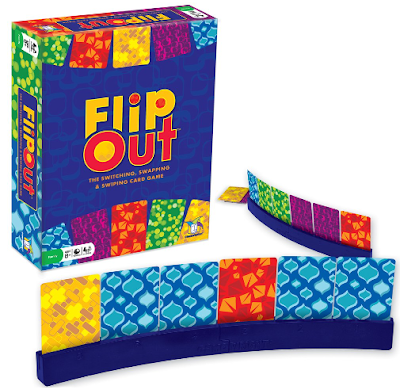 |
| Flip Out - A switching, swapping and swiping card game. |
Flip Out is a game of colorful patterns and sets. Colorful, two-sided cards, that you cannot see, allow your opponents to steal your cards, just as you're getting your set(s) together. A bummer for you, but you will also be busy doing the same to them.
There are ninety cards in the game and there are five different patterns total (blue, green, purple, orange, yellow). Some cards have the same design on both sides, but most cards have different designs on each side. They are sturdy, laminated cards that should hold up a long time. They measure 2 3/16" x 3 7/16".
The trays pieces are blue and hard plastic. Two trays will snap together to make one complete, longer tray that measures about 13".
Object:
Collect sets of 4, 5, or 6 adjacent cards of the same color.
Set up:
Each player will take 2 card holders and snap them together to make one longer holder. Shuffle the cards and set them in the middle of the players. Each player takes six cards and stands them in their holder (see image above). Teammates will see the backs of your cards, but only you should see the fronts (side of card facing you).
Play:
Players take turns. On each turn you will take any two of these actions:
- Flip - You can flip a card around in any holder (yours or an opponent's) so that the back (outside) become the front (Inside). This is the only way to see the backs of your cards.
- Switch - You can switch the position of two cards in your or any other player's holder.
- Swap 1 - You can swap any one of your cards with another player's. To swap, take (or request by number) any one card from another player's holder and replace it with one from yours. Don't flip the cards! You give and get the colors you see.
- Swap 2 - You can swap two adjacent, same-color cards from your holder with two adjacent, same-color cards in another player's. As with swapping 1 card, don't flip the cards - what you see is what you get.
- Score - Collect a set from your holder. If you have 4, 5 , or 6 adjacent some-color cards in your holder, remove and show everyone your set, then put them in a scoring pile in front of you. Immediately draw enough new cards to refill your holder to 6.
- Swipe - Collect a set from an opponent's holder. If you see 4, 5 , or 6 adjacent same-color cards on the back of another player's cards, you can take their set! However, you must give them one card (for scoring purposes). Place cards in your scoring piles: they get 1 and you get the rest. The player whose set you stole immediately draws back up to 6.
The game ends as soon as any player cannot draw enough cards to fill their holder back up to 6. At this point, anyone with a set of 4, 5, or 6 facing them in their own holder can collect it. All players count their scoring piles and whoever has the most cards wins.
Try this:
- Skip the game, sort the cards into piles by pattern/color. Hold a stack in the non-dominant hand and push the top card off, one at a time, with the thumb.
- Skip the game. Set up a tray (two halves) and start of sequence of two, such as yellow green. Ask the individual to finish the sequence to fill the tray.
- Work on visual discrimination, visual closure, manual dexterity, executive functioning skills, planning, process skills, socialization skills, play and leisure exploration and participation
In the box: 90 double-sided cards, 5 cards holders (10 halves)
If you ire interested in purchasing this game or just want more information, click on the image below.


No comments:
Post a Comment
Thank you for taking the time to comment.